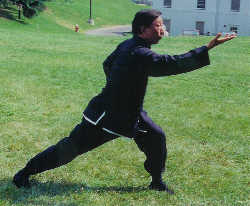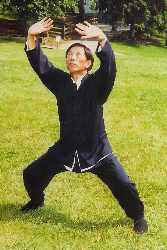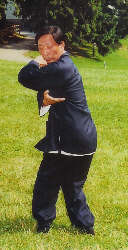This article discusses the Qi Gong methodology of Lu Shui-Tian as taught by Master Bok-Nam Park. The article is based on discussions and instruction I have had with Master Park over a number of years and is being submitted here for the benefit of all interested Qi Gong practitioners. – Frank Hriadil
Part I Review: The human body is designed for movement. It is composed of approximately 360 joints and 650 muscles that enable an almost infinite variety of large and delicate motions. These motions can range from simple gestures to highly complex and coordinated actions. It is a central principle of the natural world that there is no life without movement. As such, it is recognized in the Ba Gua Zhang method of Lu Shui-Tian that movement is a key element for maintaining the health of the body and living a normal, productive life. Movement is an inherent and fundamental characteristic of the human condition. Thus, any practice designed to improve the health of the body must incorporate movement as part of its method. But, movement alone is not enough.

Climb the Mountain Stance Movement
Part II
First, there is no single Qi Gong form or exercise that exists that fully addresses all aspects of the body. However, this does not mean that it is necessary to learn many Qi Gong forms or exercises. One only needs a few forms as long as they are the right forms, with the right characteristics that address all of the issues presented in Part I. For this reason, the method of Lu Shui-Tian has developed a number of special Qi Gong practices.
In general, in the Ba Gua Zhang method of Lu Shui-Tian, all Ba Gua Zhang forms have a dual nature. This is in keeping with the Principle of Yin and Yang. The same form may be practiced either with a Qi Cultivation (i.e. Health) focus or a Qi Release (i.e. Fighting) focus. Nevertheless, there are a few special forms or exercises that are purely Qi Gong in nature. Each of these Qi Gong practices utilizes very specific movement methods, breathing methods, and focus methods that have been integrated in a very specific way, according to Ba Gua’s underlying natural principles, to accomplish their intended purposes.
The three purely Qi Gong forms or exercises that comprise the Ba Gua Qi Gong Methodology of Lu Shui-Tian are:
- Standard Qi Gong
- Organ Qi Gong
- Kou Bu Bai Bu Qi Gong
The Standard Qi Gong (also called Basic Qi Gong) and Organ Qi Gong (also called Standard Eight Qi Gong) of Lu Shui-Tian are described and discussed, in detail, in “The Fundamentals of Pa Kua Chang” books and videos so they will only be briefly mentioned here. Kou Bu Bai Bu Qi Gong, on the other hand, has not been discussed anywhere prior to this article and will be presented in somewhat more detail. But, the intent here is not to teach Kou Bu Bai Bu Qi Gong. Rather, I simply wish to introduce Kou Bu Bai Bu Qi Gong and discuss the role that it plays in the Qi Gong methodology of Lu Shui-Tian.

Wild Goose Glides Down to the Beach Movement
Standard Qi Gong (Basic Qi Gong)
Standard Qi Gong is the basic Qi Gong practice of the Ba Gua method of Lu Shui-Tian. Its purpose is the initial development of Power Circulation and involves the development of Qi manifestation, sensitivity, and balance. It is composed of three simple looking exercises:
- Lifting Up, and Pressing Down
- Opening and Closing
- Pulling In and Pressing Out
arranged in a 9 step sequence that belies its inherent depth and power. On the outside it does not look like anything special but when practiced with a slow, smooth rhythm with the proper coordination of the breath and the mind it can produce a very powerful effect. It is through this practice that students first come to experience the Skin Qi feeling.

Horse Riding Stance Movement
Organ Qi Gong (Standard Eight Qi Gong)
Organ Qi Gong is a more complex and involved practice that expands upon the progress made in Standard Qi Gong. Its primary purpose is to continue to develop the Power Circulation skill to send Qi deep into the organs. Organ Qi Gong is composed of a warm-up that leads into eight exercises:
- Straight and Circle Fan Zhang Warm-up
- Tian Fan Zhang
- Sliding The Shutters to Look at the Moon
- Double Palm Change
- Unicorn Turns Its Body
- Serving Tea Cups
- Serving Tea Cups with Throwing Palm
- Yin and Yang Opposing Palms
- Scooping the Moon from the Sea Bottom
This practice incorporates specific turning and twisting movements characteristic of Ba Gua Zhang which serve to further loosen up the body and open the joints. Furthermore, these specific exercises are utilized because of their proven ability to stretch, massage, and move the organs in different ways to eliminate tension and cause the organs to relax. Coupled with proper breath control and mental focus, increased levels of Qi are sent deep into the organs – revitalizing them and improving their function. Master Park teaches that when the organs are properly manipulated and massaged in this manner, the Qi in the organs is strengthened. Through this practice the Skin Qi feeling continues to develop and one may begin to experience the Nerve Qi feeling in certain areas of the body.

Kou Bu Bai Bu Qi Gong
Kou Bu Bai Bu Qi Gong promotes an even deeper level of training. It focuses more specifically on developing and conditioning the joints. This involves the small muscles, ligaments, tendons, cartilage, bones, and nerves that comprise the joints. Like Standard Qi Gong, it is composed of three different exercises arranged in a sequential manner:
- Coil, Scoop, and Lift
- Scoop the Moon, Lift and Press
- Hidden Flower Under the Leaf
As with all practices in the Ba Gua Zhang method of Lu Shui-Tian, Kou Bu Bai Bu Qi Gong contains a balance and interplay of
- tension and non-tension
- twisting and untwisting
- opening and closing
- raising and lowering
- etc.
According to the Principle of Yin and Yang. In keeping with the Principle of Five Elements, it utilizes five specific stances
- Stance 1 (Climb the Mountain Stance)
- Stance 6 (Wild Goose Glides Down to the Beach Stance)
- Stance 2 (Horse Riding Stance)
- Bai Bu (Outward Step)
- Kou Bu (Inward Step)
It combines somewhat more intensive upper body and lower body movements with light but rooted stepping to drive the Qi deeper into the organs, the joints, and also the bones. The rhythm, speed, and coordination of the practice is structured in accordance with the Principle of Continuous Change.
Kou Bu Bai Bu Qi Gong is carried out in a circular stepping pattern. A slow measured rhythm is utilized in conjunction with low, high, twisted, untwisted, etc. body positions, which require very precise control of balance and very precise coordination of movement. In this way, the body’s balance and coordination are trained and developed in a more significant way. A natural, not artificial, rhythmic contraction of the Hui Yin point (i.e. the perineum) is produced that causes an increased pumping of Qi throughout the body. The specific movements utilized cause an extension and stimulation of the joints – conditioning the small muscles, ligaments, tendons, cartilage, bones, and nerves that comprise and control all of the joints in the body.
As with all Qi Gong practices in the method of Lu Shui-Tian, there is a coordination of the breath and a precise focusing of the mind. Over time and under the guidance of a qualified instructor, beginners progress from a simple normal breathing process to one that matches the breathing precisely with the form and the rhythm of movement. Similarly, practitioners progress from focusing their mind on one location to matching their focus to specific areas during specific movements.
In its outward appearance, Kou Bu Bai Bu Qi Gong (like Standard Qi Gong) does not appear fancy or complicated. But, with its adherence to natural principles and its specific focus on joint stimulation, it promotes enhanced Power Circulation. Through this Qi Gong practice, the Skin Qi feeling continues to develop. With the increased stimulation of the joints, the Nerve Qi feeling continues to grow. And, one may begin to experience the Bone Qi feeling in certain areas of the body.

Methodology of Lu Shui-Tian
Through these three fundamental and foundational Qi Gong practices, the health of the body is addressed in a comprehensive, systematic, and holistic manner. In the Ba Gua Zhang Qi Gong method of Lu Shui-Tian as taught by Master Bok-Nam Park, one finds a methodology that is based on the fundamental trinity of natural principles that govern our bodies and the universe in which we exist. And, one finds a progressive methodology in which the current practice builds on the previous practice. This does not mean, however, that once you learn Organ Qi Gong, you stop practicing Standard Qi Gong, or once you learn Kou Bu Bai Bu Qi Gong, you no longer need to continue with Organ Qi Gong. Each has a different purpose and a different emphasis. They complement each other and they all remain part of the ongoing training process.
Performing all three Qi Gong exercises continues to promote the growth of Qi skill within the practitioner – addressing the development of Qi cultivation, Qi sensitivity, Qi circulation, Qi balance, and Qi control. All three stimulate the organs, the joints, and the bones (the three critical areas of the body) to differing degrees. Over time, they lead to the development of Skin Qi, Nerve Qi, and Bone Qi feelings within the practitioner as the Qi is spread more completely and deeply throughout the body. And, all three remain necessary to develop the body in a comprehensive and holistic way.
Of course, to achieve the desired results one must understand how to properly integrate and coordinate the form (or movement), the breath, and the mind. This can only happen under the direct supervision and guidance of a qualified instructor. Qi Gong practice is applicable for everyone no matter his or her age or physical condition. It can have a profound effect on the health of the practitioner but if done incorrectly, it can cause great harm. So, it cannot be overemphasized that any serious form of Qi Gong practice is a serious matter that should only be approached with knowledge and understanding.
Is there more to the Ba Gua Zhang Qi Gong method of Lu Shui-Tian than discussed here? Yes there is, but that is a subject for another time. Nevertheless, it is my hope that this article has provided some useful insight and understanding into the practice of Qi Gong in general and the Ba Gua Zhang Qi Gong methodology of Lu Shui-Tian in particular.
In closing, I wish to leave you with the following words of wisdom from Master Park:
Any Qi Gong method, or any internal practice for that matter, cannot be judged merely by what is seen on the outside, by what is written in a book, or by how famous is its name or the name of its instructor.
What happens and is felt on the inside is what is most important and where the truth really lies.
A practice that has little substance, for whatever reason, possesses little value and will not accomplish much no matter how many years you may train.
The ultimate decision of what path or method you choose to follow is yours to make.
Life is short, so be careful to choose your path wisely.

Frank Hriadil is a Certified Instructor, Lineage Disciple of Master Park Bok-Nam, and has been involved in the internal Chinese martial arts since 1975. He is the Director of Master Park’s Boston Student Group.]

